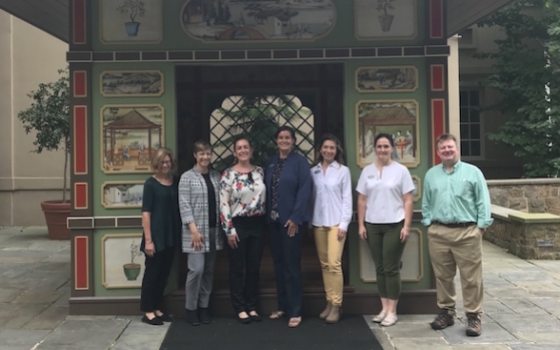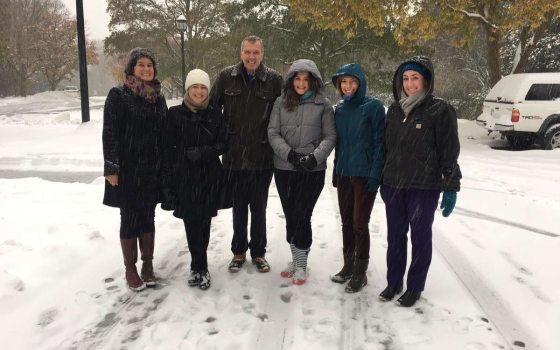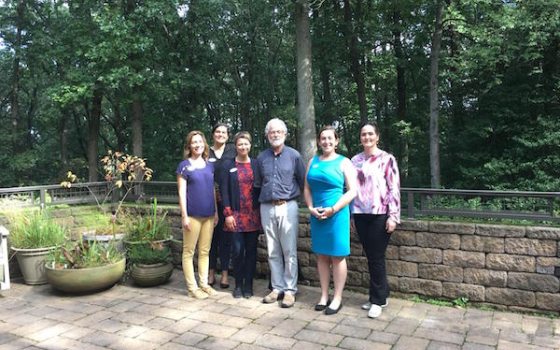Many of the region’s grand historic homes, estates, and gardens that are open to visitors thanks to philanthropy and preservation are managed by complex, behind-the-scenes organizations. Winterthur Museum, Garden & Library is a fine example of this and was aptly selected to host a salon-style discussion on “how the garden fits into institutional mission.”
As Longwood Fellows, part of our Program curriculum includes participating in salon-style discussions hosted by regional public garden and cultural arts leaders who have expertise in specific leadership-related areas. Our first salon for the 2018-19 cohort was led by Chris Strand, Director of Garden & Estate and Linda Eirhart, Director Horticulture, Senior Curator Plants at Winterthur.

As Chris and Linda guided us through the 60-acre garden surrounded by 1,000-acres of rolling hills, we explored the many facets of Winterthur. Chris spoke in detail about the history of the home and garden. We walked the asphalt paths that are a surprisingly important historic artifact of a different century—as they were ahead of the times when the main roads were still dirt. Through sweeping vistas, we studied the 175-room house, now a museum holding 90,000 objects collected between 1640 and 1860 by Henry Francis du Pont. It was the desire of H.F. du Pont to have his home and garden opened as a museum for the public to enjoy, which it did in 1951. Through his expertise and expansive knowledge of the infrastructural and property history, Chris conveyed the importance of understanding the entire context that contributes to an organization's existence.
Unique in artifacts and deep in history, Winterthur is among many renowned organizations with comprehensive missions. Drawing from our own professional backgrounds and our recent conversations with leaders at different cultural institutions, we discussed the complex relationships that exist between departments of multidisciplinary organizations and the great potential for collaboration inherent in these organizations. The challenge of honoring legacy while appealing to modern audiences provides today’s leaders of cultural institutions an opportunity to be creative and innovative—characteristics that many of our cultural property’s founders also upheld.
In the case of Winterthur, this innovative acknowledgment of past eras comes in the form of their current exhibition, Follies: Architectural Whimsy in the Garden. The show builds upon historic follies in the garden and reflects aspects of Winterthur’s collections in the museum. The 13 contemporary follies placed throughout their grounds connects garden visitors to the estate history by highlighting historic locations, prominent garden vistas, and meaningful connections to collections in the museum and library. For example, the illustrations incorporated into the Chinese Pavilion folly (pictured above) are inspired by wallpaper in the Chinese Parlor of Winterthur’s museum and the folly itself is modeled after a Chinese house at Stowe Landscape Garden in England.
The gardens and natural lands that surround the museum and 119 buildings continue to honor H.F. du Pont’s design intent. It is with a lot of work and planning that the horticulture staff is able to maintain a historic and globally recognized plant collection. Linda spoke of the responsibility of maintaining his horticultural legacy and honoring their mission, “to inspire, enlighten and delight all of its visitors while preserving and enhancing its buildings and landscape, its collections and programs, and its history as a country place." H. F. du Pont kept detailed records that are archived and can be referenced to guide modern design. While we rely on and recognize the importance of these historical records, we also acknowledge the importance of the intellectual capital held by today’s staff. Linda will soon celebrate 32 years with Winterthur. During her time, she has gained—and helped to discover—much institutional knowledge, which is an asset to any organization with such breadth and depth of history.
We left Winterthur with an appreciation of the hard work required to incorporate rich historic legacies in a modern era. The challenge of this responsibility is exciting, and something that we look forward to as we move forward in our careers. We are thankful to Chris and Linda for spending their morning with us and sharing their expertise to support us as we grow as leaders in the Longwood Fellows Program.


